|
1.
CENTRAL AND WEST AFRICA
Tariff shock waves
The president of the African Development Bank said an
onslaught of tariffs by the United States will send "shock
waves" through African economies, warning of reduced
trade and higher debt-servicing costs.
Arfica.com has quoted Ecobank CEO, Jeremy Awori, as
urging African nations to boost intra-continental trade to
cushion the impact of US tariffs which threaten many of
the continent’s economies.
The US is Africa’s fourth-largest trading partner and as
such the new tariffs could have a disproportionate impact
on the continent as they undermine demand for the
continent’s exports.
Awori called for accelerated implementation of the
African Continental Free Trade Area (AfCFTA), removal
of non-tariff barriers and more local value addition to raw
materials as a means of weathering the effects of US tariff
realignment and earlier announced aid cuts that could push
millions of people into extreme poverty.
See: https://africa.com/228500-2/
Regional update
Cameroon
Road and rail operations to Douala and Kribi Ports are
reported as generally stable and container availability
remains good with sufficient empty containers in stock.
Northern Cameroon has experienced severe flooding (with
considerable damage to housing and infrastructure
reported) but the weather has not significantly disrupted
operations in the south.
Gabon
The domestic press has quoted the Ministry of Economy
as saying in the fourth quarter of 2024 the timber industry
recorded a sharp decline marked by a 6.6% drop in the
composite index for sectoral activities compared to the
previous quarter.
This slowdown, says the press, was mainly due to
insufficient log supplies and weakening Chinese demand.
The sawmill production index posted a 5.3% quarter-on-
quarter decline for the third consecutive quarter fueled by
a sparse order book as well as operational constraints
including frequent power outages.
The veneer production index was down 4% compared to
the previous quarter. The plywood production index
recorded the sharpest decline, -24% compared to the third
quarter of 2024. This decline was explained by electricity
shortages and log availability. However, for the year
plywood production showed a notable increase of 27%.
It is reported that in Nkok’s Special Economic Zone
around 50% of Indian veneer peeler mills have closed
because of a lack of orders from their regular customers.
See: https://www.lenouveaugabon.com/fr/agro-bois/1104-20542-
bois-le-gabon-enregistre-un-repli-de-6-6-de-l-activite-au-4e-
trimestre-2024
Republic of the Congo
Operators report logging operations continue without
major disruption and road and rail transport to Douala Port
remain open with no recent changes in fees or tolls
reported.
Operations remain steady though rains and poor roads
continue to be problematic. In general, prices for some
timber species (iroko, padouk and okan) have increased
slightly but overall business remains quiet.
Chinese engagement in railway, road, housing and mining
projects continues to expand and was bolstered by the
recent visit by China’s Finance Minister. These
investments may improve local infrastructure.
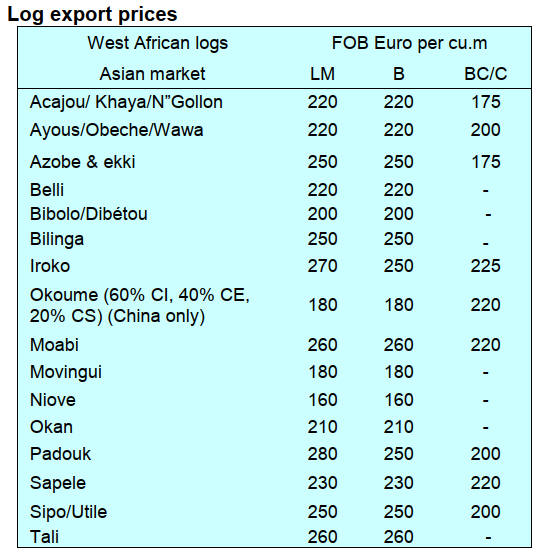
ATIBT publishes guide on tropical wood structures
The ATIBT has published a guide on African tropical
timber structures. ATIBT says the guide is a response to
requests from project owners, mainly architects, who want
to use tropical woods in public contracts due to their
particular performance but who faced difficulties in
drafting the specifications of special technical clauses.
Another objective of the guide says ATIBT is to support
and promote the certification process for sustainable forest
resource management.
See: https://www.atibt.org/files/upload/technical-
publications/guide_de_performance_des_ouvrages_africains/ATI
BT-GUIDE-DE-PERFORMANCE-DES-OUVRAGES-EN-
BOIS-V6.pdf
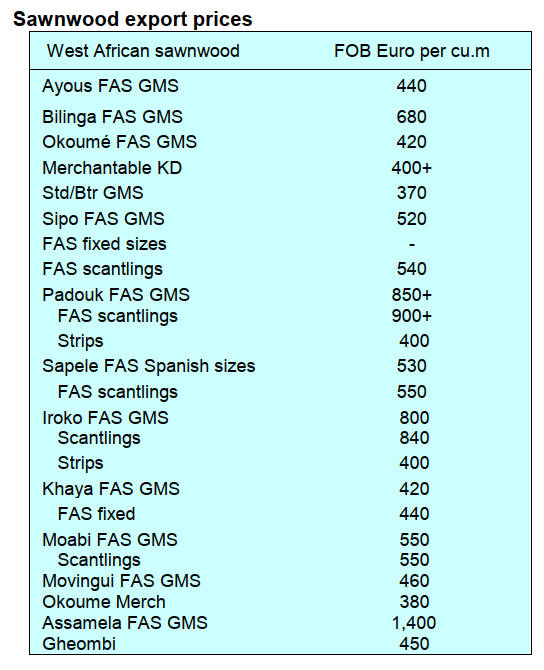
2.
GHANA
Revision of timber stumpage fees
The Forestry Commission (FC) has concluded
negotiations to increase stumpage fees starting with an
increase of 30% of the legally mandated fee as of 2 April
2025 to be gradually increased to 70% over the next two
years. This was agreed in collaboration with
representatives from the Traditional
Authorities/Landowners, the Ministry of Lands and
Natural Resources (MLNR), the Office of the
Administrator of Stool Lands (OASL) and the Timber
Industry.
Ogyeahoho Yaw Gyebi II, Omanhene of the Sefwi
Anhwiaso Traditional Area and President of the National
House of Chiefs said after the meeting he praised all
parties who attended for the peaceful and collaborative
atmosphere of engagement which resulted in the positive
outcome to the interest of all stakeholders.
The Chief Executive of the Forestry Commission, Dr.
Hugh C.A. Brown, extended his appreciation to all
stakeholders for prioritising the review. He emphasised the
importance of stumpage fees in supporting the
Commission, the traditional authourities and for national
development. He also highlighted the legal requirement
for periodic fee reviews, against macro-economic factors.
There were concerns on the current stumpage calculations
which puts Timber Utilization Contract (TUC) holders at a
disadvantage regardless of market conditions.
The chair suggested that the Forestry Commission and the
timber industry engage the government on a stumpage
formula to implement a new law that would benefit all
stakeholders.
See: https://fcghana.org/timber-stumpage-fees-revised/
Air dried sawnwood exports number one
Data from the Timber Industry Development Division
(TIDD) industry report published for January 2025
showed that air-dried sawnwood accounted for 60%
(12,440 cu.m) of the total export volume for the period
(20,594 cu.m)– to maintain its lead as the top wood
product exported.
Sawnwood exports registered a 6% volume growth when
compared to the same period in January 2024. For the
period 2021 to 2025 data also showed that the volume of
air-dried sawnwood exports accounted for at least 50% of
the total volume of timber and wood exports shipped each
year. Kiln-dried sawnwood took the second position to air-
dried during the 5-years period, accounting for an average
of 15% of the total export volumes with billet and
plywood taking the third position.
The reason for the performance of the air-dried sawnwood
export volumes compared to kiln-dried, could be attributed
to the fewer facilities of the latter and the high energy cost
associated with kiln-drying.
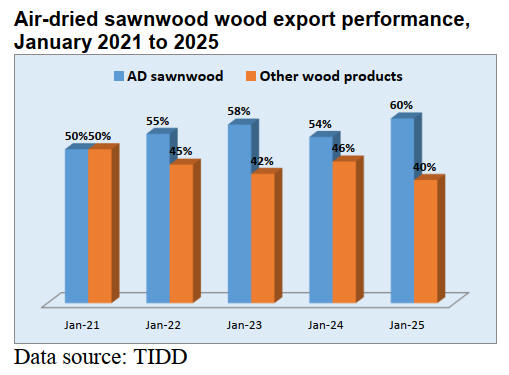
Fifty (50) registered exporters contributed to the total
export volume of the product (12,440cu.m.) for the period.
Species that went into the production of sawnwood
included teak, denya, kako/ekki, niangon, dahoma, ananta,
essa/celtis, odum and dahoma.
While the major market for sawnwood was Asia (India,
85% and Vietnam, 8% twelve other countries accounted
for 7% of the total volume.
For the period in 2025, air-dried sawnwood product
accounted for 52% of export receipts (Eur 5.10 million)
compared to 4.73million in the previous year.
US 10% tariff - call for strengthening local content
policy
The 10% across the board tariff on all Ghanaian exports to
the US is anticipated to have a dire impact on Ghana’s
future commodities trade including wood products.
The president of the Association of Ghana Industries
(AGI), Dr. Humphrey Ayim-Darke, has cautioned that the
weak implementation of the country’s local content policy
has left the economy vulnerable to external shocks such as
the new US tariff on Ghanaian exports.
On its website the policy think tank IMANI Africa -
Ghana says it sees the action by the US as an opportunity
for the country and recommended that Ghana expand its
trade partners beyond the US to build the leverage to
export the same commodities to other markets during such
crisis.
It further stated that strengthening Ghana’s regional value
chains under the African Continental Free Trade Area
(AfCFTA) is very crucial. The statement added that by
that Ghana can create more demand for local goods and
reduce its vulnerability to external shocks such as the
recent tariffs.
The report also emphasised that Ghanaian exporters must
improve product quality, branding and packaging to
differentiate their goods in competitive markets. Exports
to the US have been increasing in both volume and value
for the last few years.
See: https://imaniafrica.org/2025/04/criticality-analysis-of-
economic-issues-31st-march-to-5th-april-2025/
and
https://thebftonline.com/2025/04/10/u-s-tariffs-a-wake-up-call-
for-africas-economic-self-reliance-afcfta-chief/
90% plus businesses are in the informal sector
According to a Ghana Statistical Service (GSS) survey
(Ghana 2024 Integrated Business Establishment Survey)
92% of businesses in Ghana are in the informal sector.
This was disclosed by (the then) government Statistician,
Professor Samuel Kobina Anim, who indicated that these
informal businesses were identified as entities which fail
to keep any formal book-keeping accounts. The report
revealed that during the period 2014-2024 over 1.2 million
businesses were established with most of these recording
low revenues annually.
The GSS identified that at least 55% of large-sized and
medium-sized privately owned establishments are in the
formal sector. Timber processing companies fall into the
medium-sized establishments which are largely privately
owned .
See: https://www.myjoyonline.com/92-3-of-businesses-in-
ghana-remain-informal-gss/
and
https://www.myjoyonline.com/ghanas-economy-estimated-at-
gh%c2%a21-17trn-gss/
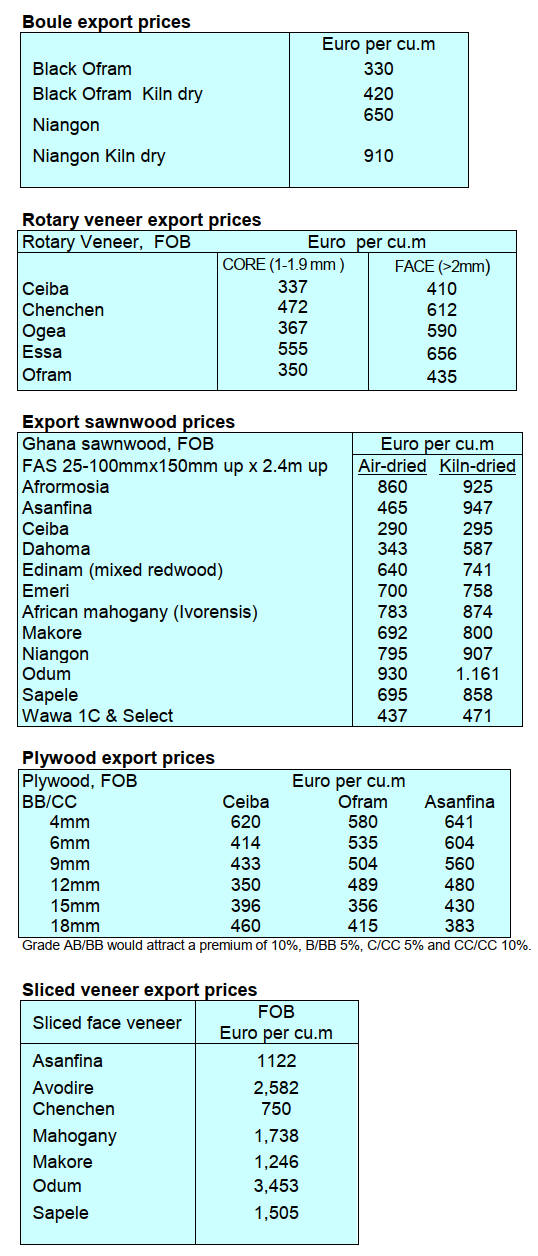
3. MALAYSIA
Discussions on measures to withstand tariff storm
Like many other countries the recently introduced tariffs
by the United States have dominated the news headlines
and also the focus of the business community. In 2024,
Malaysia’s timber exports to the United States were
RM198.65 bil out of a total export of RM 1,508 bil.
Key measures to help Malaysia withstand the global tariff
storm from the United States are being discussed by the
Ministry of Investment, Trade and Industry (Miti).
Among the measures being explored are possibly
diversifying Malaysia’s current trade and investment
interests as well as strengthening the country’s supply
chains.
Miti also said the government would continue to engage
with the United States by leveraging its influence in the
Malaysian-US Trade and Investment Framework
Agreement. Malaysia, as the chair of ASEAN, will also
engage in discussions with several member states of the
bloc to reach a collective approach.
See:
https://www.thestar.com.my/news/nation/2025/04/04/measures-
to-help-malaysia-weather-trump-tariff-storm-being-discussed-
says-miti?gsid=11efc45a-0e05-47d7-8d64-58dcf2acab09
US importers ask for delayed furniture shipments
The furniture industry has been advised to delay shipments
to the United States following the imposition of a 24%
tariff by the US government. The Malaysian Furniture
Council’s deputy president, Matthew Law, said this signi-
ficant tariff has resulted in some manufacturers postponing
shipments due to the prevailing market uncertainty, “some
US customers have requested us to temporarily hold off on
shipments” he said.
He added “the situation remains unpredictable and it is
unclear how much of this cost will be passed on to
consumers as manufacturers may absorb some of the
impact of duties. ”
The United States is a crucial market for Malaysian
furniture accounting for 60% of the country’s exports as of
February 2025.
Steve Ong Yeou Huan, president of the Federation of
Johor Furniture Manufacturers and Traders Associations,
confirmed that several American clients have requested
furniture exporters to temporarily suspend shipments to
the United States.
“Some furniture export orders are currently on hold due to
the uncertainties surrounding the new tariffs,” he said. He
added “although the 24% tariff imposed on Malaysia is
lower than that for some other countries, clients may
eventually shift their production to nations with even
lower tariffs which would undermine Malaysia’s
competitiveness.”
See:
https://www.thestar.com.my/news/nation/2025/04/08/furniture-
shipments-to-us-put-on-hold-for-now
All forest workers must be certified
The Sarawak Timber Association (STA) has called on its
members to accelerate the training of their forest workers
to ensure compliance with the Forests (Trained Workmen)
Rules, 2015. STA chairman, Henry Lau, said all forest
workers must undergo training and obtain Forest Worker
Certificates to support sustainable forest management
(SFM).
According to Lau, these certificates are now mandatory for
license renewals and approvals for the Permit to enter
Coupe, as required by the Director of Forests. Lau also
highlighted that, since the skills sets offered by the STA
Training Co Ltd (STAT) were registered with the Human
Resources Development Corporation, members should
take advantage of STAT’s training provider status.
Looking ahead, Lau said STAT planned to expand its
training programmes significantly in the coming years to
offer more opportunities for skill development to meet
evolving industry standards and regulatory requirements.
See:
https://theborneopost.pressreader.com/article/281560886598209
AI tool contributes to forest assessment
Telekom Research & Development Sdn Bhd (TM R&D), a
subsidiary of The Multimedia University (MMU) was
recognised at the Malaysia Technology Excellence
Awards 2025 in the AI - Environmental Services category.
This recognition celebrates a breakthrough in Smart
Forestry AI Tools Enhancement which contributes to
forestry assessments and advances biodiversity
conservation in Malaysia.
The AI-powered solution, launched in 2024, utilises a
mobile app that captures tree images and calculates tree
diameters (DBH) without the need for additional
equipment or reference objects. This innovation
significantly reduces the time taken for data collection.
See: https://www.mmu.edu.my/2025/04/tm-rd-wins-malaysia-
technology-excellence-award-for-ai-powered-smart-forestry-
innovation/
4.
INDONESIA
Export Benchmark Price (HPE) April 2025
The following is a list of Wood HPE from April 1 to April
30, 2025.

Processed wood (prices per cu.m)
Processed wood products which are leveled on all four
sides so that the surface becomes even and smooth with
the provisions of a cross-sectional area of 1,000 sq.mm to
4,000 sq.mm (ex 4407.11.00 to ex 4407.99.90)

Processed wood products which are leveled on all four
sides so that the surface becomes even and smooth of
Merbau wood with the provisions of a cross-sectional area
of 4000 mm2 to 10000 mm2 (ex 4407.11.00 to ex
4407.99.90) = US$1,500/cu.m
See: https://jdih.kemendag.go.id/peraturan/keputusan-menteri-
perdagangan-republik-indonesia-nomor-446-tahun-2025-tentang-
harga-patokan-ekspor-dan-harga-referensi-atas-produk-
pertanian-dan-kehutanan-yang-dikenakan-bea-keluar-1
Furniture entrepreneurs voice concerns on US tariff
policy
Abdul Sobur, Chairman of the Indonesian Furniture and
Craft Industry Association (HIMKI), expressed concern
that the reciprocal tariff policy implemented by the US
will significantly impact the furniture and craft industries
in Indonesia.
According to the list released by the US government
Indonesian export products to the US (until the latest
changes) faced a reciprocal tariff of 32%. Sobur explained
that the immediate effect will be felt on furniture and
crafts being shipped to the US, particularly those departing
before April 9 and thereafter.
He said "53% of our exports go to the United States while
the remaining products are sent to Europe and other Asian
countries. Any goods currently en route or just departed
would be as the shipping time is approximately one
month. By the time they arrive the pricing structures will
have changed."
Any increase in tariffs would lead to a decline in exports
of furniture and crafts from Indonesia to the US. The US
market may shift to countries offering similar products at
lower prices. "Indonesian forest products and furniture
exported to the US will incur higher costs, this is
significant and will likely reduce the competitiveness of
Indonesian furniture products in the US", Sobur
concluded. In related news, the Indonesian Furniture and
Craft Association (Asmindo) has highlighted the possible
adverse effects of import tariff proposed by the United
States.
Asmindo pointed out that the US accounts for 60% of
Indonesia's total furniture exports, around US$2.2 billion.
Any introduction of these new tariffs, according to
Asmindo Chairman, Dedy Rochimat, would result in a
decline in the competitiveness of Indonesian furniture
products in the American market. "This decline in utility
will ultimately lead to a reduction in the workforce," Dedy
stated.
See: https://www.cnnindonesia.com/ekonomi/20250404141758-
92-1215816/53-persen-ekspor-ke-as-pengusaha-mebel-was-was-
kebijakan-tarif-trump.
Assessing impact of US tariffs
Indonesia's Coordinating Minister for Economic Affairs,
Airlangga Hartanto, said that the imposition of US
reciprocal tariffs will have a significant impact on several
export sectors. Airlangga said that the Indonesian
government would immediately take strategic steps to
mitigate the negative impact on the economy.
According to him, the US reciprocal tariffs will have a
significant impact on Indonesia's exports to US
competitiveness. Indonesia's main exports to the US are
electronics, textiles and textile products, footwear, palm
oil, rubber, furniture, shrimp and marine fishery products.
Airlangga said the government will continue to
communicate with the US government at various levels
and will send a high-level delegation to Washington.
See: https://rri.co.id/en/business/1432760/govt-to-calculate-
impacts-of-us-reciprocal-tariff-minister
Indonesia to boost US imports
Indonesia plans to boost imports from the US in an effort
to narrow the trade deficit.. Coordinating Minister for
Economic Affairs Airlangga Hartarto explained that the
decision is part of ongoing negotiations and said "we will
increase the volume of purchases so the US$18 billion
trade deficit can be reduced."
See: https://en.tempo.co/read/1994262/indonesia-to-boost-u-s-
imports-to-offset-trade-gap-as-32-tariff-looms
Minister seeks collaboration to end poverty
Social Affairs Minister, Saifullah Yusuf, has invited
Forestry Minister, Raja Juli Antoni, to support poverty
elimination through community empowerment
programmes run by the Ministry of Forestry. "We want
these (vulnerable, poor and extremely poor) groups to be
empowered by programmes of ministries such as the
Ministry of Forestry" Minister Yusuf said.
He added that the Ministry of Forestry can empower
residents living around forest areas to reduce poverty. "We
can select residents living around forests and they can
carry out forest-based economic activities.
See: https://en.antaranews.com/news/350061/minister-seeks-to-
collaborate-with-forestry-minister-to-end-poverty
Forest monitoring Ap to strengthen traceability
Indonesia's vast forests present significant challenges for
monitoring. To address this Kaoem Telapak has launched
a forestry monitoring application Ground-truthed.id
(GTID).
This application is designed to assist in monitoring and
tracing products including those from forestry, agriculture
and plantations that are subject to the EUDR. This
application can be accessed via the web and Android
devices to collect and manage forestry monitoring data
from civil society groups, indigenous peoples and local
communities.
The aim of GTID is to enhance transparency,
accountability, and advocacy efforts in the fight against
illegal logging, deforestation, land grabbing, and
environmental injustice.
See: Ground-truthed.id
Indonesia and Australia to develop furniture industry
skills
The Ministry of Industry is ramping up efforts to boost the
performance of Indonesia’s domestic furniture industry,
aiming to strengthen its contribution to national GDP and
expand export markets. The Kendal Polytechnic signed a
Memorandum of Understanding (MoU) with CAD+T
Australasia Pty Ltd and Pradita University to improve
skills in the furniture sector.
See: https://www.rri.co.id/internasional/1434312/indonesia-
australia-develop-digital-talent-for-furniture-industry
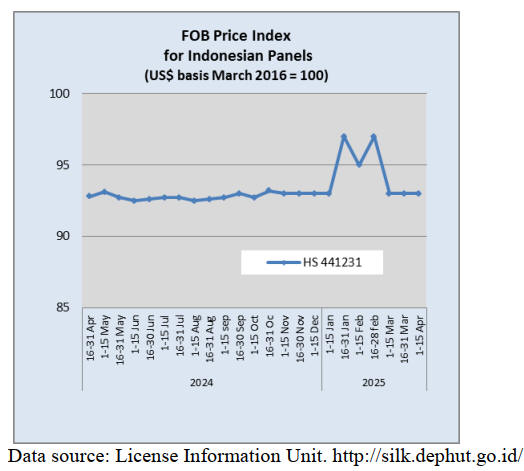
5.
MYANMAR
Myanmar reeling from multiple crises
The Myanmar state television reported that the death toll
from the earthquake near Mandalay had, as of 11 April,
surpassed 3,000 with around 4,500 people being injured.
Although the recent earthquake did not cause significant
physical damage to the export sector as key industries,
such as wood processing and garment manufacturing are
mainly in Yangon where the tremors were mild, however,
indirect impacts are inevitable. The most visible impact in
Yangon is power shortages with the rotational supply of 4-
hour on and 8-hour off.
TMyanmar says the country is reeling from overlapping
crises; political turmoil, economic stagnation and recurring
natural disasters. The World Bank had already projected a
meager 1% economic growth for the fiscal year ending
March 2025, down from an average of 6% annually
between 2011 and 2019, a period of democratic hope and
poverty reduction. Analysts warn that the earthquake’s
fallout could push growth into negative territory.
See- https://www.worldbank.org/en/country/myanmar/overview
ASEAN mobilises disaster fund
The ASEAN Disaster Management and Emergency Relief
Fund has been activated to support Myanmar following
the devastating 7.7 magnitude earthquake. ASEAN
Secretary-General Dr. Kao Kim Hourn said the regional
bloc is now shifting its focus toward long-term recovery
efforts.
"This reflects the collective commitment among ASEAN
member states to respond to humanitarian crises in the
region," said Kao. The earthquake, which killed over
3,000 people and caused widespread damage across
Myanmar, also triggered tremors felt in Thailand and
Laos.
The Malaysian Prime Minister, Datuk Seri Anwar
Ibrahim, urged ASEAN to deepen its engagement with
Myanmar, emphasising the importance of adhering to
humanitarian principles and the five-point consensus
framework.
See -
https://www.bernama.com/en/news.php?id=2410893 and https://
www.bernama.com/en/news.php?id=2411187
December election confirmed
Myanmar Government has reaffirmed its commitment to
holding a general election in December, despite the
challenges in the aftermath of the devastating earthquake
in March. This announcement was published in the state-
run Global New Light of Myanma.
See - https://thediplomat.com/2025/04/myanmar-juntas-affirms-
december-election-despite-earthquake-chaos/
Multi-exchange rate system questioned
Critics are saying some economic policies adopted by the
State Administration Council (SAC) may have violated
Myanmar’s international economic obligations. One of the
most significant violations of its international economic
obligations is the adoption of a multiple exchange rate
system. These rates are set by administrative diktat and do
not reflect market conditions.
Through the Central Bank of Myanmar, the SAC has
access to 25% of export earnings from most exporters at
the official rate of 2,100 MMK to a US dollar, about half
the market rate. Recent IMF guidelines require that the
effective exchange rate be no more than plus or minus 2%
lowere than the theoretical reference price.
See- https://fulcrum.sg/myanmars-military-regime-is-violating-
its-international-economic-obligations/
6.
INDIA
Pause in sawnwood price
increases
The annual rate of inflation based on the all India
Wholesale Price Index (WPI) was 2.38 in February. The
positive rate of inflation was primarily due to increases in
prices of manufacture of food products, food articles, other
manufacturing, non-food articles and textiles.
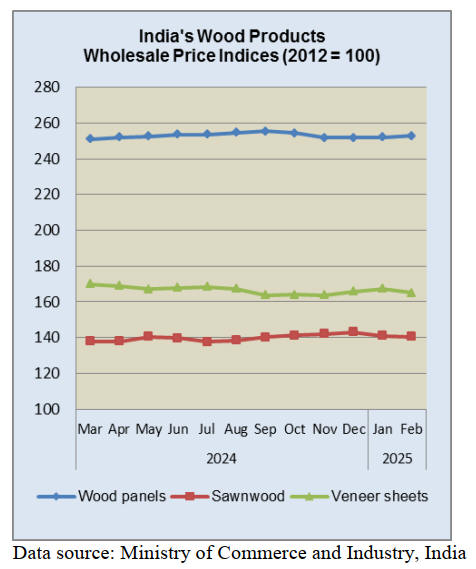
The index for manufacturing increased to 143.8 in
February from 143.2 in January. Out of the 22 NIC two-
digit groups for manufactured products, 17 groups
witnessed an increase in prices, 2 groups witnessed a
decrease in prices and 3 groups saw no change in prices.
Some of the important groups that showed month on
month prices increases were ‘other‘ manufacturing,
manufacture of food products, basic metals, other non-
metallic mineral products and chemicals and chemical
products.
Some of the groups that saw a decrease in prices were
manufacture of wood and of products and leather products.
See: https://eaindustry.nic.in/pdf_files/cmonthly.pdf
Panel industry had a tough final quarter
Plyreporter has said the Indian wood panel industry
witnessed a tough final quarter in the 2024-2025 financial
year mainly due to a liquidity crunch, payment delays and
introduction of the new Quality Control Order (QCO) on
panel products.
The correspondent reports imports of panel products such
as MDF, plywood, Blockboard, particleboard and doors
stopped because of the QCO.
Strong demand for new homes
Housing demand in India is expected to grow further due
to budget tax incentives and a recent interest rate cut, says
CREDAI in a press release. CREDAI points out demand
for housing continues to be strong and is expected to grow
further on the back of tax incentives offered in the budget
and a recent intersst rate cut, said the CREDAI president.
In a recent interview the CREDAI president asserted that
there are no signs of demand slowdown in the Indian
housing market, rather it will continue to rise in the long-
term horizon. However, he said there could be an impact
in some markets that are "over-heated" but overall at pan-
India level there are no concerns at all.
According to a CREDAI study average housing prices
across the top eight markets in India witnessed a 10%
YoY rise during the last quarter of 2024 led by healthy
demand momentum and positive market sentiment.
Average house prices have been rising for the past 16th
consecutive quarters starting 2021.
While affordable housing segment will continue to form
the bulk of housing sales, demand within luxury and ultra-
luxury segments can amplify further in 2025. Movement
in these segments is likely to drive average housing prices
up across most major residential markets of the country in
the next few quarters. Overall unsold inventory continued
to decline for the fourth consecutive quarter and dropped
5% annually during Q4 2024 backed by healthy demand.
In related news, in April the Reserve Bank of India (RBI)
recently cut interest rates from 6.25% to 6%, a second cut
since February when rates were brought down after nearly
five years. The RBI also lowered its growth projections for
this year from 6.7% to 6.5%.
Analysts point out the RBI shifted its monetary policy
stance to "accommodative" from "neutral", which means
that the central bank would be more open to cutting rates
in the future to stimulate a slowing economy.RBI
governor, Sanjay Malhotra, said in a speech "concerns on
trade frictions are coming true and unsettling the global
community” adding that headwinds from disruptions to
trade would continue to pose challenges for the economy.
See: https://www.credai.org/media/view-details/545
and
https://economictimes.indiatimes.com/industry/services/property-
/-cstruction/housing-demand-strong-prices-to-grow-this-year-at-
more-than-inflation-rate-credai-prez-boman-
irani/articleshow/119072779.cms?from=mdr
Rupee depreciation a problem for importers
The Indian rupee’s performance in 2024 was a problem for
importers. By year end the rupee had depreciated by
approximately 3% against the US dollar the
implications of which were far-reaching.
In 2025 India’s trade deficit widened, putting pressure on
the rupee as the country spent significantly more on
imports than it earned from exports. To make matters
worse, foreign institutional investors withdrew from
Indian equity markets between October and
December. This lead to a sharp demand for the dollar and
further weakened the rupee to an all-time low of 87.3
against the US dollar.
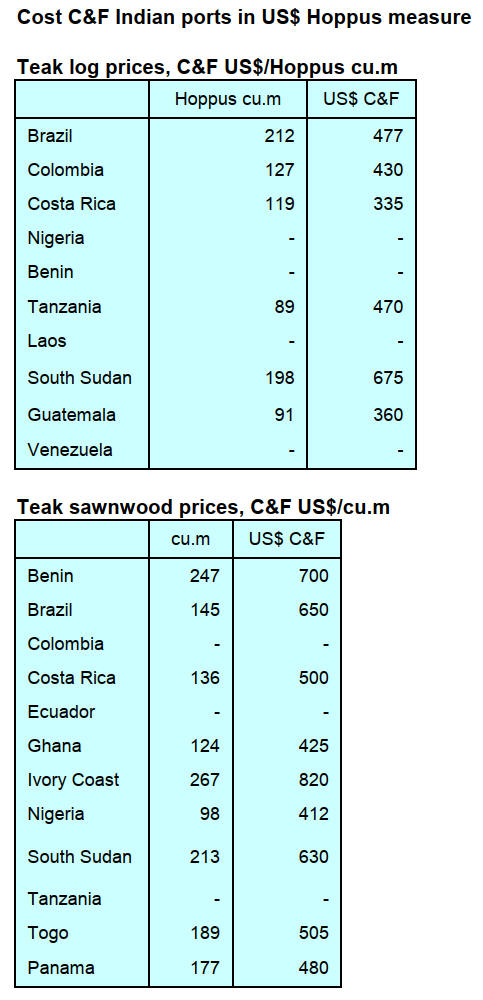

Plywood
The recently announced price increases have now been
introduced.
 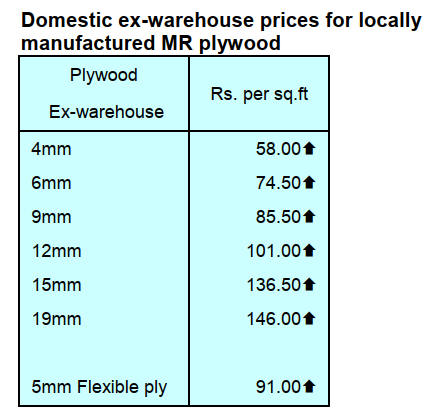
7.
VIETNAM
Wood product exports surged in March
It is estimated that Vietnam’s W&WP exports in March
2025 reached US$1.5 billion, an increase of 46%
compared to February 2025 and an increase of 15%
compared to March 2024. Of this WP exports contributed
US$1.01 billion, up 52% from February 2025 and up 13%
from March 2024.
For the first three months of 2025 total W&WP exports
recorded US$3.95 billion, up 12% over the same period in
2024. Of which WP exports accounted for US$2.67
billion, up 11% over the same period in 2024.
W&WP exports to the US in March 2025 fetched US$764
million, up 46% from February 2025 and up 9% from
March 2024.
For the first three months of 2025 total exports to the US
reached US$2.07 billion, up 9% over the same period in
2024.
Vietnam's exports of office furniture in March 2025
amounted to US$27.7 million, an increase of 32% from
February 2025 and an increase of 15% from March 2024.
For the first three months of 2025 exports of office
furniture earned US$78.5 million, up 22% over the same
period in 2024.
Vietnam's W&WP imports in March 2025 were valued at
US$260.0 million, up 25% from February 2025 and up
35% from March 2024.
Vietnam's imports of oak in March 2025 were 41,300
cu.m, worth US$24.4 million, an increase of 24% in
volume and 25% in value compared to February 2025 and
up 20% in volume and 19% in value compared to March
2024.
For the first three months of 2025 imports of W&WP
totalled 96,200 cu.m worth US$57.4 million, up 30% in
volume and 34% in value compared to the same period in
2024.
Vietnam enterprises seek immediate aas well as long-
term solutions
The new tariff policy that the United States announced for
products imported from Vietnam will have a significant
impact on Vietnamese enterprises, particularly those that
are heavily reliant on the US market, especially the timber
sector.
Timber industries are responsible for a substantial portion
of Vietnam's exports and the any change in import taxes
are viewed with concern. Anticipating potential risks,
Phung Quoc Man, Chairman of the Handicraft and Wood
Industry Association of Ho Chi Minh City (HAWA),
stated that HAWA conducted a survey of 50 exporters.
The aim was to gather information, ideas and proposals
from enterprises in order to identify the most effective
solutions to support them in the short and long term.
The United States is the primary market for 52% of the 50
enterprises in the survey and this market accounts for more
than 50% of their export revenue.
Businesses anticipate that the implementation of
countervailing duties by the United States could result in
an immediate decrease in order volumes and a reduction of
new orders from customers according to the survey.
The supply chain has been severely disrupted as a result of
numerous clients' requests for delayed
shipments. Simultaneously, price pressures are increasing
as consumers are requesting price reductions. Despite the
fact that input and labour costs have not decreased this
imposes additional responsibilities on suppliers to ensure
the stability of prices.
Businesses now have to deal with the issue of excessive
inventories as a result of their inability to export products
which has resulted in financial strain and a decrease in
profitability. Many companies have been forced to shut
factories or suspend production, resulting in job losses and
severely impacting workers’ incomes.
In terms of long-term challenges, timber industry
businesses caution that the negative impact will be even
more pronounced if this tax rate continues to be applied
for an extended period. One of the primary hazards that
Vietnamese enterprises may encounter is the loss of
market share and the resulting decline in competitiveness
in comparison with countries such as Thailand, Malaysia
or Mexico.
The competitive advantage of Vietnamese wood products
is declining as a result of the excessively high tariffs.
Consequently, customers are likely to relocate their
sourcing to countries with reduced tariffs, thereby
reducing Vietnam's primary export markets.
This not only reduces revenue but also makes it difficult to
sustain existing markets, forcing companies to seek out
new markets,a costly and time-consuming process.
Furthermore, businesses are being compelled to restructure
their production models in response to substantial cost
pressures. This not only results in instability but also
diminishes profit margins and even poses a bankruptcy
risk for numerous small and medium-sized enterprises.
Shifting markets to mitigate dependence on the US
In an effort to mitigate dependence on the US market,
numerous wood industry enterprises affiliated with
HAWA have proactively transitioned to alternative
markets including Japan, Australia, Europe and
Canada. In order to sustain production and stimulate
growth certain enterprises are also actively pursuing new
partners and customers to replace US buyers.
In addition to market diversification, businesses are also
striving to reduce production costs by enhancing labour
efficiency and sourcing more cost-effective raw materials
to reduce the overall price of products. At the same time,
many enterprises are placing greater emphasis on
enhancing design and product quality to create
differentiation and increase added value.
Nevertheless, not all enterprises have established specific
strategies. Some enterprises are still unprepared, as they
have been entirely dependent on the US market. They are
currently awaiting official updates from government
authorities or feedback from customers.
Enterprises are advocating for the Vietnamese government
to ramp-up negotiations with the US in order to mitigate
duties.
A gradual and reasonable tariff reduction roadmap, in
conjunction with the reduction of export and import tariffs
on American wood materials, would provide businesses
with additional time to adjust to the new business
environment.
"Enterprises also hope that the government will consider
and promote policies to help balance the trade relationship
between Vietnam and the US. Reducing export tariffs on
wood products and increasing financial support for
exporters are crucial measures to help them weather this
difficult period.
HAWA has requested assistance in the form of legal
consultation and information to address the current
situation," said Phung Quoc Man.
See: https://vietnamagriculture.nongnghiep.vn/wood-enterprises-
seek-market-shift-d747048.html
Vietnam’s wood exports surged in early 2025 but face
mounting headwinds
Continuing the growth seen in 2024, Vietnam's wood
exports reached US$3.95 billion in the first quarter of
2025 marking a 12% year-on-year increase. March exports
alone accounted for an estimated US$1.5 billion in wood
and wood product exports.
The United States is Vietnam’s largest export market for
wood and wood products, making up 53% of total exports.
Japan and China followed, accounting for 13% and 11%
respectively. Despite this robust performance, the wood
sector continues to grapple with considerable challenges.
A large proportion of Vietnam’s wood businesses are
small and medium-sized enterprises (SMEs), many of
them family-run operations. These firms are particularly
vulnerable to market fluctuations and often struggle with
the modernisation of production and processing
technologies.
Supply-side constraints also persist
Vietnam lacks a stable domestic supply of large-diameter
wood forcing companies to rely heavily on imports.
This dependency not only inflates production costs but
also diminishes the competitiveness of Vietnamese wood
products in global markets.
Additionally, while demand remains steady in core export
destinations, Vietnam’s wood exports remain overly
concentrated in a few key markets. Such market
dependence poses long-term risks, especially amid
ongoing global geopolitical uncertainty.
US tariffs threaten industry outlook
Ngo Si Hoai, Vice President and Secretary-General of the
Vietnam Timber and Forest Product Association
(Viforest), recently addressed the mounting challenges
enterprises face and urged businesses to prepare for
market headwinds.
In 2025, Vietnam’s agriculture sector aims to generate
US$18 billion in wood and wood product exports, up
US$2 billion from the previous year. The US is the main
target market for much of this growth however, the tariff
policy casts a shadow over these ambitious goals.
The stakes are especially high for the wood sector which
generates the largest trade surplus among Vietnam’s
agricultural exports to the US.
Over the past four years US imports of Vietnamese wood
products has consistently ranged from US$7–9 billion
annually, accounting for over 50% of Vietnam’s total
wood exports. In contrast, Vietnam imports only around
US$300 million in wood products from the US annually.
The sudden announcement of a 46% tariff, nearly double
the 25% that was anticipated shocked the industry.
Compounding the issue is an ongoing investigation under
Section 232 of the U.S. Trade Expansion Act of 1962
which assesses whether wood imports pose a threat to
national security. While this probe has yet to result in new
duties, the possibility remains.
In the short term, Hoai advises Vietnamese businesses to
ship goods before any final ruling or tariff enforcement,
aiming to minimise losses and to re-evaluate operations.
Broader market strategy needed
One of the key strategies being pursued by Vietnam’s
agriculture ministry is to prove the complementary not
competitive nature of US and Vietnamese agricultural
products including wood. This argument is central to
ongoing trade negotiations.
At a recent meeting with the US Ambassador, Vietnam’s
Minister of Agriculture and Environment, Do Duc Duy,
emphasised that the two countries' agricultural exports are
mutually supportive and should not be seen as adversarial.
He also affirmed Vietnam’s openness to importing more
US agricultural goods.
To that end, Viforest, in coordination with local trade
associations, exporters and relevant ministries is preparing
to participate in upcoming hearings. Their goal: to
demonstrate that Vietnam-US wood trade is mutually
beneficial and poses no threat to the US domestic industry.
Still, Hoai cautioned that diplomacy alone may not suffice
“We need to do more than just talk. The key now is for
Vietnamese agencies and enterprises to consider
increasing imports of US wood products such as
sawnwood, logs and veneer in order to rebalance trade and
underscore the benefits of cooperation.”
Another critical area is raw material sourcing. To build a
strong and competitive wood industry capable of meeting
international demand businesses must invest in
sustainable, legal timber supplies with forest management
certification. This is essential not only for increasing
export orders but also for meeting the country’s broader
sustainability goals.
See: https://antidumping.vn/vietnams-wood-exports-surge-in-
early-2025-but-face-mounting-headwinds-n28621.html
FDI firms play significant role in Vietnam's wood
industry
Foreign direct investment (FDI) businesses have played a
significant role in Vietnam's wood industry, one of the
country's biggest export earners. A 2024 report on FDI
activities in Vietnam's wood industry showed that last
year, the number of new FDI projects in the industry
increased by 73% in terms of investment capital year-on-
year according to a report released by Forest Trends, the
Vietnam Timber and Forest Products Association
(VIFOREST) and local timber associations.
Companies from mainland China led both in number of
new projects and share purchases. Out of 61 new projects
invested by 16 countries and territories, 25 were of
mainland China. Projects focused on wood processing,
including products such as beds, cabinets, tables, chairs
and sofas. Taiwan P.o.C followed with five new projects
worth US$129.62 million.
The report anticipated that in 2025 the Vietnamese wood
industry will continue to witness a shift in investment
across regions and countries globally with growing
importance of the FDI sector's role as manufacturers seek
to diversify risks and seize opportunities in new markets.
Industry experts noted that the substantial increase in FDI
activity highlights the growing prominence of Vietnam’s
wood industry, especially in view of the impact of U.S.
policies in the next four years. Experts from Forest Trends
stated that amid escalating trade wars due to new US
import tax policies and corresponding retaliatory measures
from trade partners the trend of increasing FDI in
Vietnam’s wood industry is inevitable.
See: https://theinvestor.vn/fdi-firms-play-significant-role-in-
vietnams-wood-industry-research-d14816.html
8. BRAZIL
Native forest restoration in Brazil
The new National Plan for Native Vegetation Restoration
(Planaveg) launched by the Ministry of Environment and
Climate Change (MMA) presents a strategy to restore 12
million hectares of native vegetation by 2030 in line with
Brazil's commitment under the Paris Agreement.
According to Planaveg 2025-2028, the proposal combines
four cross-cutting strategies, monitoring, support for the
production chain, financing and research, alongside
specific implementation arrangements aimed at restoring
native vegetation in permanent preservation areas, legal
reserves, restricted-use areas, public lands and low-
productivity rural properties.
A study published in Biological Conservation identified 76
million hectares of priority areas for restoration across the
six Brazilian biomes, based on biodiversity and ecological
connectivity criteria.
A study highlights that restoring just 30% of these priority
areas could increase available habitat for native species by
up to 10% and enhance habitat connectivity by 60%.
In the Atlantic Forest the loss of mature forests between
2010 and 2020 totaled more than 186,000 hectares with
73% of this loss occurring on large private properties. The
analysis, based on remote sensing and geospatial data,
revealed weaknesses in enforcement and significant
anthropogenic pressures on the biome including within
protected areas.
The findings emphasise the need for integrated public
policies, grounded in robust scientific data, to guide large-
scale ecological restoration efforts focused on ecosystem
resilience, biodiversity conservation and climate change
mitigation.
In related news, the National Bank for Economic and
Social Development (BNDES) and Petróleo Brasileiro
S.A. (Petrobras) have established an unprecedented
partnership through the ProFloresta+ program.
This focuses on ecological restoration of degraded areas in
the Amazon and the promotion of the carbon credit
market.
The initiative targets the restoration of up to 50,000
hectares of native forest and an estimated sequestration of
15 million tons of carbon, representing one of the largest
restoration-based carbon credit acquisition programs in the
country.
In its initial phase the programme will purchase up to 5
million carbon credits over an area of approximately
15,000 hectares, with investments exceeding R$450
million solely for restoration and generating around 4,500
jobs. The programme aims to make reforestation
economically viable by strengthening the ecological
restoration sector and establishing technical and legal
benchmarks for the market.
See: https://www.maisfloresta.com.br/pesquisa-aponta-areas-
prioritarias-para-restauracao-da-vegetacao-nativa-do-brasil/
See: https://www.maisfloresta.com.br/bndes-e-petrobras-firmam-
parceria-para-reflorestar-a-amazonia-e-fortalecer-o-mercado-de-
creditos-de-carbono/
Assessing impact of US tariff changes
The imposition of a minimum tariff of 10% on Brazilian
products by the United States government has raised
significant concerns in the forest sector of Paraná State. As
the US is the primary destination for Paraná's timber
product exports such as plywood, sawnwood and pine
framing the measure could undermine the competitiveness
of the local industry.
Last year, the Southern states (Paraná, Santa Catarina and
Rio Grande do Sul) exported a total of US$1.37 billion in
wood products to the US representing over 85% of Brazil's
total timber sector exports according to the American
Chamber of Commerce for Brazil (Amcham).
The Organization of Cooperatives of the State of Paraná
(Ocepar) also highlights that other sectors such as coffee,
iron and steel, may be affected. Nevertheless, the
Federation of Agriculture of the State of Paraná (FAEP)
sees potential opportunities for Brazil to gain access to
new markets amid the restructuring of global trade.
While FAEP is awaiting the official details of the US
decision it is already engaging with the federal
government coordinating action aimed at mitigating the
impact on the timber industry. The United States is the
main export destination for Paraná's wood and any tariff
barriers would represent a significant challenge to
maintaining employment in the sector.
See: https://apreflorestas.com.br/noticias/taxacao-dos-eua-
industria-florestal-do-parana-analisa-riscos-de-perda-de-
mercado-e-aumento-nos-custos-de-producao/
Value of profiled wood exports plunging
Profiled wood, Para state´s main export product saw a
64% drop in export value. The timber sector in the State is
facing a challenging scenario. Although the exported
volume grew by 18% in the first two months of 2025
compared to the same period in 2024 when 41,400 tonnes
were exported generating approximately US$21.1 million,
the total export value dropped by nearly 40%.
This decline primarily affected profiled wood, the state´s
main export product, which saw a 64% drop in export
value. Contributing factors include fluctuations in
international demand, growing pressures for
environmental certifications, and changes in trade policies
in foreign markets.
According to Aimex (Associação das Indústrias
Exportadoras de Madeiras do Estado do Pará) the sector's
main challenge lies in obtaining environmental export
licenses from the Brazilian Institute of Environment and
Renewable Natural Resources (IBAMA) for species such
as Ipê, Cumaru and Cedro.
The recent requirement for CITES and LPCO (Export
Licensing Document) authorisations has led to delays in
trade of legally produced timber. This has resulted in the
retention of hundreds of containers at ports and company
yards which has compromised logistics efficiency and is
resulting in financial losses. Aimex has called on IBAMA
to implement a more efficient system for processing
licenses.
Timber industry leaders have raised concerns on the
excessive bureaucracy and lack of institutional capacity in
IBAMA. The local timber sector remains attentive shifts in
the global market and reinforces its commitment to high-
quality and sustainable production practices. However, the
sector warns that without immediate action, the
competitiveness of Brazilian timber will continue to
decline in relation to international competitors.
See: https://www.oliberal.com/economia/setor-madeireiro-do-
para-tem-queda-de-40-nas-exportacoes-e-busca-estrategias-para-
se-fortalecer-1.931839
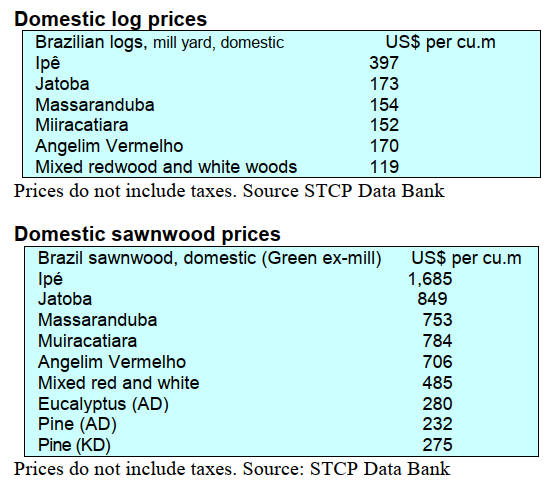 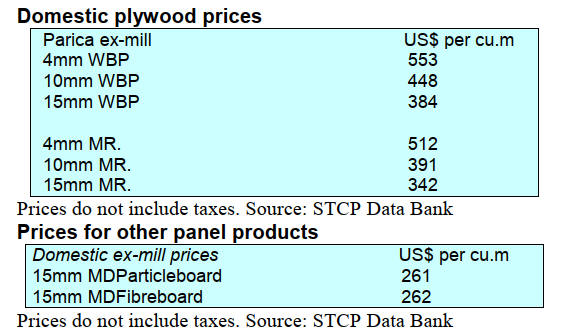
Export prices
Average FOB prices Belém/PA, Paranaguá/PR,
Navegantes/SC and Itajaí/SC Ports.
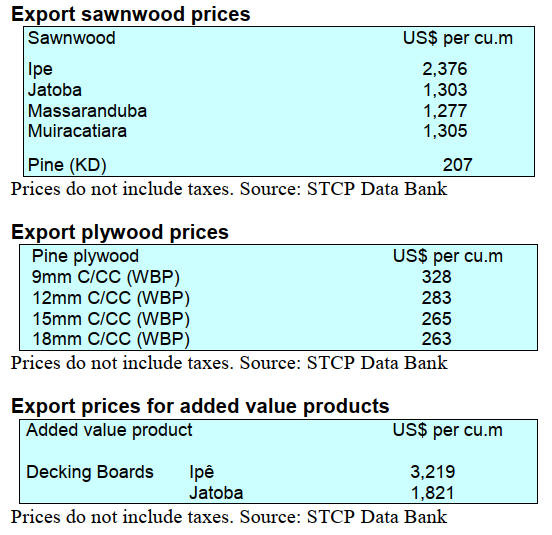
9. PERU
Exports of shihuahuaco
impacted by CITES
The inclusion of the Shihuahuaco and Tahuari timber
species in Appendix II of CITES announced in 2022 and
made official in November 2024 has had a significant
impact on the export of shihuahuaco one of the most
widely used timber species in the joinery sector, said Erik
Fischer Llanos, president of the Timber and Wood
Industries Committee of the Association of Exporters
(ADEX).
CITES Appendix II includes species that, while not
necessarily in danger of extinction, could become so if
their trade is not properly regulated. In the case of Peru,
Article 46 of the Forestry and Wildlife Law establishes
inspection of 100% of the more than 9,000 registered
shihuahuaco trees adding an additional layer of control to
their commercialisation.
“Based on technical evidence, this CITES decision was
made without solid evidence, with alterations in official
information and without conclusive evidence that the
species was in danger of extinction. This has caused
uncertainty and jeopardised the sustainability of formal
forestry activities”, warned Fischer Llanos.
Forestry sector stakeholders meet with government
authorities
The Ucayali Forest Producers Association participated in
the second session of the Executive Committee for the
Development of the Forestry Sector sponsored by the
Ministry of Economy and Finance.
The meeting was held to promote agreement that
strengthen the sector's competitiveness and define
strategies to ensure the legal origin and controlled
movement of timber in Peru, said its president, Luis López
Panduro.
This meeting was attended by SERFOR, the Ucayali
Regional Government, the San Martín Regional
Government, the Specialized Environmental Prosecutor's
Office (FEMA), OSINFOR, the Ministry of the
Environment, the Ministry of Production of Peru, the
ADEX Exporters Association, the National Society of
Industries and other national institutions.
"It is hoped that, based on the recommendations made by
the country's forest producers and the commitments made
at the meeting conditions will be created to boost timber
exports”, López Panduro concluded.
Ucayali producers committed to sustainability
In the Ucayali Region 45 forest concessionaires reaffirmed
their commitment to the sustainable management of the
Amazon forests. After successfully completing the five-
year audit conducted by the Forest and Wildlife Resources
Supervisory Agency (OSINFOR), these producers can
request an extension of their forest concessions for a
period of up to 20 years.
This achievement was possible thanks to the positive
reports provided by OSINFOR and the collaborative work
with the Ucayali Regional Forestry and Wildlife
Management Office.Initiatives such as this strengthen
forest governance in the Peruvian Amazon and reaffirm
the importance of working toward the sustainability of
natural resources.
See: https://www.gob.pe/institucion/osinfor/noticias/1141588-
productores-forestales-de-ucayali-renuevan-su-compromiso-con-
la-sostenibilidad

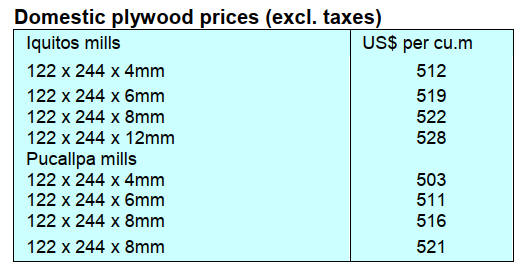
|